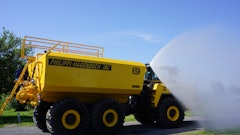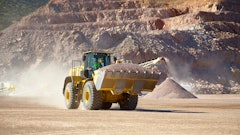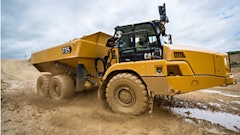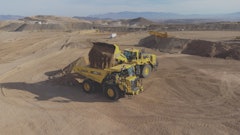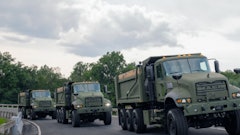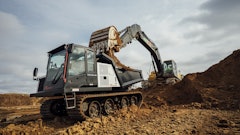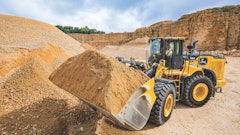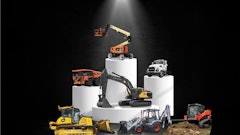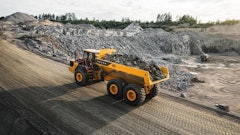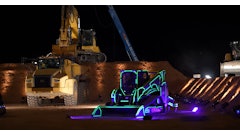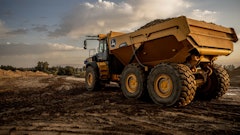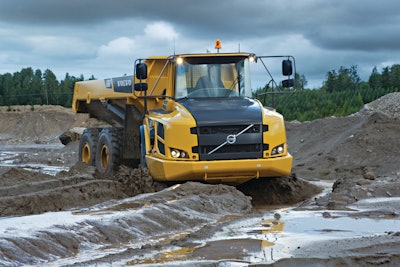
The advantages of buying new include the latest technology for increasing productivity and reducing operating costs. “The trend is to want higher production per man hour — more simply put, the ability for one operator to move more dirt in a work day,” says Ken Emmett, product manager, Terex Construction Americas.
Contractors need to move more material per gallon of fuel. To that end, many manufacturers have noted an increase in fuel economy with Tier 4 Interim technology.
“In addition to meeting the new emissions standards, Terex Generation 9 articulated trucks equipped with Scania engines deliver fuel efficiency and low maintenance costs, resulting in low total ownership cost for the end user,” Emmett asserts. “The Selective Catalytic Reduction (SCR) engine requires nothing more than to have the diesel exhaust fluid (DEF) tank topped off when the truck is fueled. The DEF is environmentally benign, costs far less than diesel and application is as simple as adding windshield wiper fluid to the truck. When the DEF tank needs filled again, an indicator light signals the driver in advance of the actual need.”
Volvo Construction Equipment’s new range of articulated haulers comes with Volvo D11, D13 and D16 Tier 4i engines that feature V-ACT (Advanced Combustion Technology). The engines give the haulers over 5% more horsepower and up to 20% more torque than older models. A new variable geometry turbocharger and high-pressure fuel injection that delivers more efficient fuel burn promote fuel efficiency. The turbocharger provides quick engine response and high torque at low and high engine speeds. New crankcase ventilation in the engines helps to make for an even cleaner environment by ensuring that no oil mist is present in the blow gasses.
With the release of its Tier 4 Interim articulated dump trucks, Komatsu’s focus was to reduce fuel consumption and increase productivity. “The Komatsu Tier 4 articulated trucks reduce fuel consumption (gallons per hour) through energy saving improvements in the transmission, axles and advanced electronic engine control,” claims Rob Warden, product manager, Articulated and Rigid Trucks. “Through lowering fuel consumption with the increase in productivity, the cost per ton ($/ton) is lowered.”
Technology Boosts Productivity, Lowers Costs
Volvo has equipped its F Series trucks with an Automatic Traction Control (ATC) system. This new standard control feature provides a seamless transition between the 6x4 and 6x6, reducing fuel consumption up to 6%. In addition, the ATC system extends tire life by 10% and protects the driveline from unnecessary damage and wear.
ATC selects 6x4 drive when in the normal mode, which saves fuel, and only engages 6x6 drive when the operating conditions require. Sensors control the differential locks with signals to the truck’s electronic control unit (ECU). The slightest wheel slip is sensed and the ATC system engages the needed drive combination immediately.
The Komatsu Traction Control System (KTCS) improves operation in soft ground conditions. “This system is designed to automatically apply the inter-axle lock when ground conditions cause a difference in axle speeds,” says Warden. “Once applied, the KTCS system looks at the individual wheel speed on the front and middle axle. If it notices a difference in wheel speed from left to right on either axle, it will automatically brake the faster wheel. This system is automatically applied so the operator does not have to press any buttons or switches, allowing the operator to concentrate on navigating the machine.”
Terex has upped productivity through the use of onboard electronics. “The most significant advancement in our current Generation 9 articulated truck is the vehicle’s electronic technology,” says Emmett. “The electronic technology installed on the trucks allows our transmissions to shift at the proper times relative to load and speed, as well as helping the brakes and retarders to be applied appropriately.”
All Terex articulated trucks are equipped with state-of-the-art computerized systems that communicate through a CAN-bus system, which helps the trucks run at peak efficiency.
“This technology indicates to operators factors like the truck’s body being up, when a component on the truck needs servicing, where the component is and what it is doing,” says Emmett. “For example, Terex truck models equipped with a tire inflation warning system know if a tire is low on nitrogen, and it will indicate to the driver which tire it is and how long before it needs replacing. Through the CAN-bus system, the truck data can be transmitted via satellite to almost any location on Earth, enabling operators, fleet managers and service technicians to be kept up-to-date on the truck’s condition.”

![Hcm Ax Landcros Dual Branded Logo[25]](https://img.forconstructionpros.com/mindful/acbm/workspaces/default/uploads/2025/11/hcmaxlandcros-dual-branded-logo25.Qhg3vUCjoK.jpg?auto=format%2Ccompress&bg=fff&fill-color=fff&fit=fill&h=100&q=70&w=100)
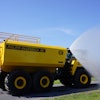
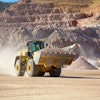
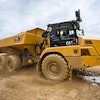
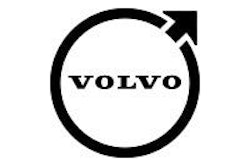
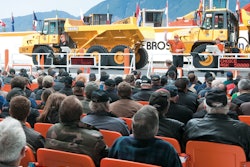
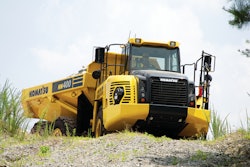
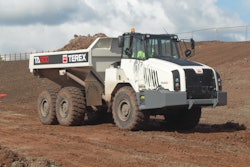
![Hcm Ax Landcros Dual Branded Logo[25]](https://img.forconstructionpros.com/mindful/acbm/workspaces/default/uploads/2025/11/hcmaxlandcros-dual-branded-logo25.Qhg3vUCjoK.jpg?ar=16%3A9&auto=format%2Ccompress&bg=fff&fill-color=fff&fit=fill&h=135&q=70&w=240)
